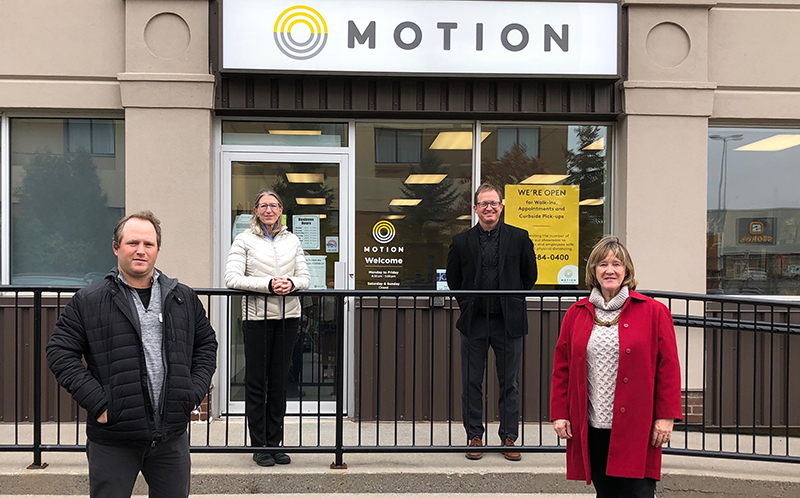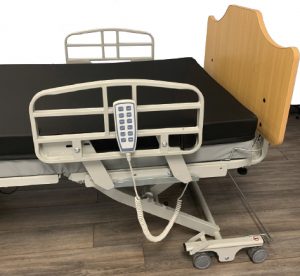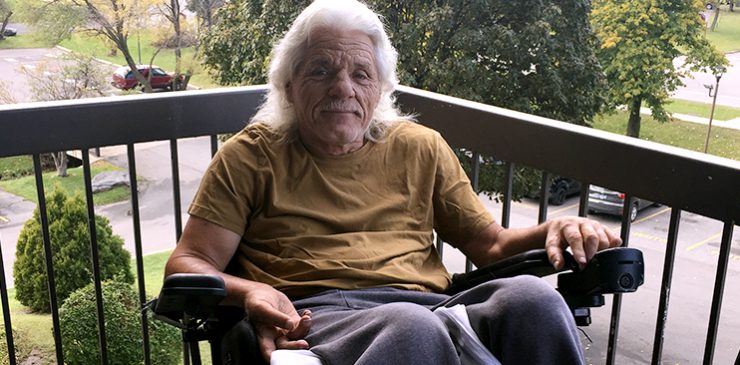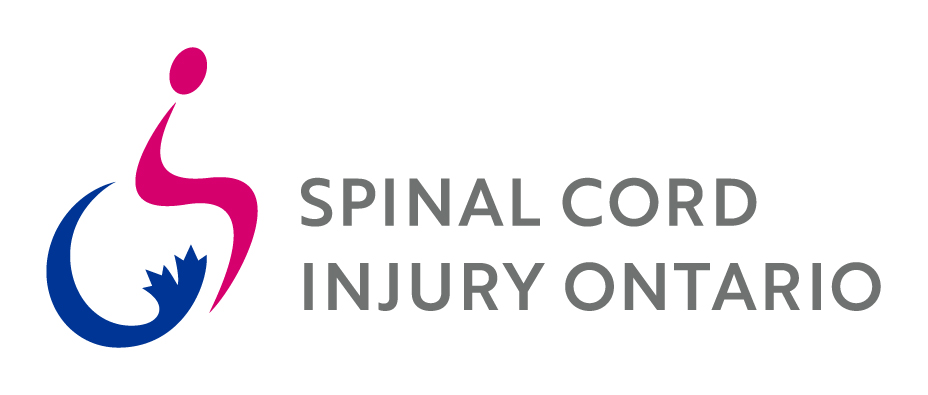This is my lifeline to staying healthy and living longer,” says Hilton Simzer, who experienced a spinal cord injury almost 40 years ago. “I couldn’t even measure the difference it makes in my quality of life.”
Hilton is referring to an adjustable electric bed with a pressure relief surface recently received from SCIO after a long, complicated and collective effort involving his Physiatrist, Community Occupational Therapist, and SCIO Regional Services Coordinator, along with manufacturer Permobil Canada and accessibility solutions provider Motion.
Because the Ontario Government’s Assistive Devices Program (ADP) does not support specialized beds and support surfaces, Hilton found himself at a loss as to how to overcome his recurring pressure injuries caused by the use of a standard bed and mattress. He not only requires frequent repositioning but also a low air loss mattress to prevent tissue damage.
Having been in and out of hospital to address his pressure injuries, Hilton and his professional care team know how effective the therapeutic bed and mattress are for maintaining his health. They also know how prohibitive their cost is as non-funded items.
“It’s frustrating that people like Hilton can’t get the funding they need—and therefore the therapeutic devices they need—to keep them healthy and out of the hospital system,” says Dr. Karen Smith, a physician at Providence Care Hospital in Kingston, Ontario and professor at Queen’s University School of Medicine.
“We recently had Hilton in our rehabilitation centre for a month to treat his injuries,” she says. “He received the same support and care he currently has at home, with one notable exception: an electric, adjustable bed with a pressure distribution surface. His injuries began to heal phenomenally. We discharged him home and, within four weeks, his injuries were back, same as before. He doesn’t have the equipment he needs to maintain his health.”
Dr. Smith explains that working with patients with spinal cord injuries often requires taking on an advocacy role. Given the cost of essential equipment and supplies not covered by ADP—from lifting devices and ramps to commode chairs, catheters, hospital beds and mattresses—there are always concerns with discharging patients who can’t afford the cost of their supplies and equipment.
“The catastrophe here is that it would be far cheaper for the Ontario government to supply Hilton with the equipment he needs than to pay for his hospital stays,” says Dr. Smith. “It’s more than reasonable to assume that he would need rehabilitation care and also acute care, should his injuries worsen resulting in sepsis. Never mind maximizing patient independence and quality of life. Those are also compromised by living with chronic tissue damage.”
Occupational Therapist, Ruth Whiting, who has worked with Hilton over the past few years, says that many clients with a spinal cord injury need an electric bed and pressure relief systems to avoid and heal injuries. Like Dr. Smith, she finds herself engaged in funding searches to help her clients. Ruth and SCIO have previously helped Hilton secure funding for his wheelchair, wheelchair repairs, seating cushions and batteries.
“When it comes to ADP-approved equipment, Hilton needs help paying for the 25% not covered by the program,” says Ruth. “There are charities that support these co-payments but might not be able to fund the remaining amount. With a bed and mattress, there are hardly any options for funding, government or otherwise.”
Ruth explains that when clients with an SCI are discharged from hospital—whether after their injury or after secondary complications—the Local Health Integration Network (LHIN) can provide only two months maximum of rental equipment to help pressure injuries heal. In addition, the LHIN’s limited pressure relief mattress options are not sufficient for higher needs clients.
In the end, gaps in the system place additional workloads on people like Ruth. Many community therapists are contracted services and are not compensated for time spent on funding searches, applications, and coordination between different groups and agencies. They do it out of professional responsibility and because they care about their clients. Without charities stepping in to work with occupational therapists in partnership, the funding gaps would be even greater.

Spinal Cord Injury Ontario also helps clients with funding shortfalls. Regional Services Coordinator, Bryce Donald met Hilton when he asked for help acquiring more cost-effective continence supplies. Bryce tried to get him enrolled in the Ontario Disability Support Program (ODSP), but Hilton’s income is just above the cut off. Yet, he cannot afford the cost of needed supplies.
“More than 80 percent of clients I see lack full funding when it comes to equipment and supplies,” says Bryce. “I would say I have helped about a dozen clients acquire a specialized bed or pressure relief mattress. If we can’t locate funding, they stay in the hospital or they’re discharged and then the clock starts ticking. Clients can rotate in and out of hospital care to help manage secondary complications.”
In addition to the funding gap so many clients face, Bryce describes a knowledge gap between what health teams know their patients need to stay out of the hospital and what the Ontario government is willing to subsidize for their care.
“What’s interesting about Hilton is that he’s a very independent, strong willed, do-it-yourself kind of guy,” says Bryce. “He has only recently reached out to SCIO, because his supply costs have started to outpace his income. He now needs additional care for his pressure injuries. He wouldn’t ask for anything if he didn’t need it. And neither would Dr. Smith, who contacted me about the bed that will prevent re-injury and recurring hospital stays.”

With no way to fund the equipment deemed necessary for Hilton, Bryce was forced to escalate this situation to SCIO’s senior leadership, who in turn solicited support from its corporate donors. Two new members then joined “Team Hilton” to help him regain his health and live independently: Mike Piccin, National Clinical Education Manager for Permobil Canada, and Jeff Preston, Director of Product and Marketing at Motion.
As a provider of mobility and accessibility solutions, Jeff is well aware of the funding shortfalls many people with disabilities face. He has helped Motion clients to access funding for essential devices, either to make up for what’s not covered by ADP or to cover the full cost of non-funded equipment.
“It’s abundantly clear that Hilton needs a low air loss mattress and an electric bed to help him with positioning,” says Jeff, who is also involved in advocacy work to build awareness about assistive devices and to impact government policy. “It’s in everyone’s best interest for Hilton and others like him to live safely and independently at home. Assistive devices play a huge role in that, but the funding model has not evolved to meet clients’ needs holistically.”
Jeff believes in Motion’s mission of “Make Life Accessible” when it comes to getting quality, life-enhancing devices to those who need them.
“This is a human rights issue,” says Jeff. “The gaps in our system strip people of the quality and dignity of life they deserve. Hilton is not looking for some kind of special treatment. He’s looking to get up every day and go about his life without continual re- injury. How is that asking too much of our society?”
With a commitment to providing Hilton with the therapeutic surface he requires, Jeff contacted Permobil to see if they could help with the bed. Permobil is guided by its founding philosophy that every person with a disability has the right to compensate as far as possible with high-quality technologies.
“We would never say that electric wheelchairs are essential devices while electric beds are not,” says Mike Piccin of Permobil. “But the Ontario government makes that distinction. So people like Hilton face an extremely poor quality of life without the equipment they need to remain healthy. He can access funding for his daytime hours but not for his nights. That imbalance prevents him from participating fully in life.”
Permobil donated its electric, adjustable Tröst bed to Hilton, along with side rails. The bed is compatible with the therapeutic support surface also manufactured by Permobil, called SelectAir, that Motion donated. Between the two companies, and with some help from the Rotary Club of Kingston, Hilton received about $11,000 worth of essential equipment.
“Hilton can’t heal without the right products,” says Mike. “And many people just can’t afford them. But in the end, those products cost just a fraction of years of hospital care. And they dramatically change people’s lives.”
Hilton is now benefitting from that change and is optimistic that his injuries will heal.
“I’m hoping to see a big improvement by the spring,” he says. “I’ve been less and less mobile, more confined in my apartment, and in a lot of pain. With this bed and mattress, I believe I will get my life back. I appreciate how hard everyone has worked on my behalf. My message to all of them is, thank you for helping me to take care of me.”
SCIO, with Bryce’s leadership, was able to resolve Hilton’s life-threatening situation, but Hilton is one of hundreds of people in need of life-changing support.
Until the Ontario government modernizes its funding and provides better public coverage for essential equipment and supplies, it will fall on the generosity of caring members of our community to alleviate the suffering of people falling through the funding gap.
Can you help?An effective way to help people get the essential equipment they need is to make a donation to SCIO’s equipment program, Enhancing Independence. Through negotiation and donations of equipment, SCIO’s RSCs can facilitate even more equipment needs. Please consider a donation today sciontario.org/essential |






